Nail Product lifting, in the context of nail care, refers to the separation or detachment of nail products, such as acrylic or gel enhancements, from the natural nail. This issue occurs when the applied nail product loses its adhesion to the natural nail, leading to gaps between the product and the natural nail or even complete detachment.
Product lifting can manifest in various ways, ranging from subtle gaps at the back of the nail (PNF) to extensive lifting of the entire nail enhancement. It can be a frustrating and disheartening experience for both clients and nail technicians, as it undermines the efforts put into creating beautiful and durable nail designs.
This phenomenon can be caused by a combination of factors, including improper nail preparation, incorrect application techniques, curing product that is touching the skin, allergic reactions to the products, and external environmental influences.
Comprender las causas del levantamiento de productos de clavos es crucial para prevenir su aparición y abordarlo eficazmente cuando se produce.
En las siguientes secciones, exploraremos los factores que contribuyen al levantamiento del producto, los signos y síntomas comunes a los que hay que prestar atención y los pasos que hay que dar para prevenir y tratar este problema, garantizando que las mejoras de las uñas sigan siendo impresionantes y duraderas.
Comprender el levantamiento de productos para las uñas
To effectively address and prevent product lifting in nail enhancements, it’s essential to grasp the underlying mechanics and contributing factors. By gaining a deeper understanding of why product lifting occurs, nail technicians can implement strategies to enhance adhesion and provide clients with enduring, flawless nails.
¿Qué es el lifting de productos ungueales?
Product lifting occurs when the bond between the nail enhancement product (such as acrylic, gel, gelpolish or dip powder) and the natural nail bed weakens or breaks. This separation leads to gaps, air pockets, or complete detachment of the enhancement from the natural nail. Understanding the root causes of product lifting is pivotal in devising preventive measures and corrective actions.
Factores que contribuyen al levantamiento del producto ungueal:
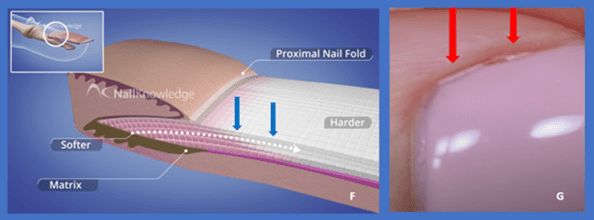
Touching any of the skin around the nail plate during product application This is one of the main problems we see, in the salon and at home, this will always cause ‘lifting’ because the nail plate is in perpetual motion 24/7 and the skin moves in the opposite direction, it sloofs off in a vertical direction this stops the product being sealed on the nail plate, water & oils get underneath and the nail enhancement lifts off of the nail plate, this tempts you or your client to pick at it and this in turn creates the perfect environment for pathogens to settle and reproduce and the recovery of that nail can take months!
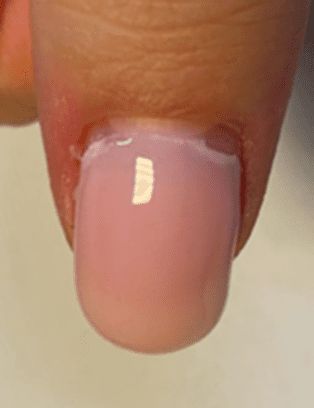
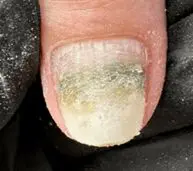
Otros factores pueden contribuir al levantamiento del producto ungueal
- Preparación inadecuada de las uñas: No preparar adecuadamente la uña natural limpiándola, deshidratándola y eliminando el exceso de grasa puede dificultar la adherencia.
- Técnicas de aplicación incorrectas: La aplicación de productos para uñas demasiado espesos, desiguales o apresurados puede provocar aire atrapado, mala adherencia y levantamiento final.
- Reacciones alérgicas: Some clients might be allergic to certain chemicals present in nail products, causing irritation and lifting due to their body’s immune response.
- Manos en el agua Using a hard nail products on weak nails that are always in water is detrimental to product adhesion because the nail plate is full of water it swells up & when this water evaporates the nail plate shrinks – this puts the product under continuous pressure –
- Medio ambiente Factores: La exposición a la humedad u otros elementos externos durante o después de la aplicación puede comprometer la unión entre el embellecedor y la uña natural.
- Forma y longitud de las uñas: Las uñas con una curvatura extrema o una longitud excesiva pueden sufrir una mayor tensión en el realce, lo que puede provocar su levantamiento.
Diferenciar la elevación de productos de otras cuestiones
It’s important to distinguish product lifting from other nail-related concerns, such as chipping, peeling, or breakage. Product lifting specifically refers to the detachment of the enhancement from the nail bed, while other issues might involve issues with the enhancement itself or the natural nail structure.
Al comprender estos aspectos, los técnicos de uñas pueden aplicar estrategias preventivas durante los procesos de preparación y aplicación de las uñas. Las secciones siguientes de este artículo profundizarán en el reconocimiento de los signos de levantamiento del producto, la comprensión de sus causas y la exploración de técnicas para prevenirlo y gestionarlo eficazmente.
Nail Product lifting – Sounds Simple Enough, Right?
Pero, ¿cuál es la causa?
- Cutícula de la lámina ungueal
- Aceite o suciedad en la lámina ungueal
- Recontaminación de la lámina ungueal tras la limpieza
- Uso excesivo de imprimación
- Incorrect use of base coat
- Producto no curado
- Placa ungueal inestable
a. mordedor de uñas
b. placa de la uña limada demasiado fina - Mordedores de uñas
a. Placa ungueal insuficiente para colocar el producto
b. Utilización de consejos - Incorrect size and fit of artificial nail tips
a. Old glue - Colocación incorrecta del formulario
a. Clavo plano, colocación de forma curva
b. Clavo curvo, colocación de forma plana - Producto en contacto con la piel durante la aplicación
- Incorrect mix ratio L&P
a. Aplicación desigual
i. Dejar puertas en el PNF
ii. Product running into the lateral nail folds - No utilizar el sistema adecuado para el tipo de uña específico
- Elevación de bolsillo
a. Trauma
b. Pellizcos
c. Debilidad de la placa ungueal - Nail plate affected by Hyperhidrosis (Commonly affected areas include the: armpits. palms of your hands, possibly nail units)
- Placing product underneath the eponychium (after excessive efile manicure)
- Sistemas de mezcla
Let’s have a Look at them in More Detail
Cutícula de la lámina ungueal
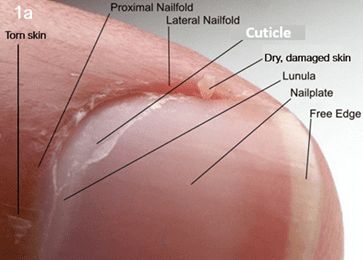
La cutícula está hecho de tejido elástico no vivo y se pega a la placa para clavos cells as they come through the eponychium. It is one of the four guardian seals. It protects the nail matrix from pathogens that we come across in our daily lives, and that’s a good thing. However, when it comes to our artificial nail products, it can cause real problems. We need to remove it con cuidado! It doesn’t need aggressive removal with a drill bit rotating at 20.000 RPM. If you think that’s ok, try it on the bonnet of your neighbor’s (new) car, and see what happens! Use your favorite good-quality nail oil & a curette, and you’re done in a couple of minutes.
Figura 2a shows a nail plate with cuticle on. There is no light reflection in the cuticle. We all work with lights so seeing it should be no problem. If you can’t see it, buy a loupe or some glasses 😊
Figura 2b shows a nail plate without cuticle – the light reflects through the whole length of the nail.
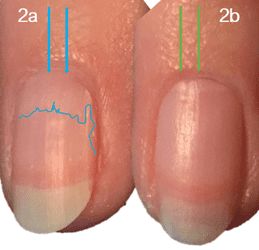
Aceite, minerales o suciedad (todavía) en la lámina ungueal
Durante los cierres de Covid-19, todas estábamos encantadas de poder volver a trabajar. En muchos países, grupos de expertos en uñas cedieron su tiempo gratuitamente para ayudar a los salones a encontrar formas de trabajar siguiendo prácticas seguras. Las prácticas higiénicas eran elevadas.
Washing hands with soap & water is one of the most effective ways to remove oil, minerals, and dirt from hands (feet) and nails. It takes almost no time at all – we should always do it, especially at the start of our service.
When you have finished removing the cuticle, and shaped the free edge with your file, let your client wash their hands de nuevo with soap, water, and a soft nail brush, dry them well, and continue with your favorite nail plate cleanser. 2 minutes now save 30 minutes of problem-solving in about a week’s time! Allow yourself those couple of minutes. I promise that you will be rewarded with much less product lifting – good for you, good for your client.
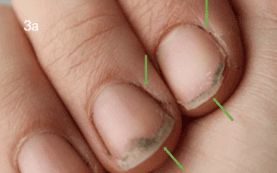
*Don’t forget, nail dust or dust from filing off artificial nail products can cause lifting problems at the free edge too! All the more reason for a quick wash after filing.
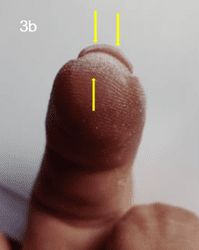
Recontaminación de la lámina ungueal tras la limpieza
This is an interesting one that we don’t always realize is happening.
Sometimes working with artificial nail products takes time. Maybe you need to place forms and you’re not fast at that yet. Or the form got stuck on the nail plate. Maybe you are taking your time creating the right structure with a builder base coat. Whatever it may be, it does not matter. We don’t all work at the speed of light, and all of us work hard to improve our speed. Maybe our client is having an emotional day, maybe they rubbed their face after all your prep work. All these things can re-contaminate a nail plate after you have prepped it. If things take you a little longer, do one hand first. When it is complete, start the second hand. That way you greatly reduce the chances of it happening.
Uso excesivo de imprimación
Los primers tienen una función en el mundo de las uñas: ayudan a adherir los productos a las placas de las uñas problemáticas. De hecho, algunos productos para uñas artificiales los necesitan para adherirse correctamente. Todo empieza por el estado de la uña natural.
- Removing the upper layer of the nail plate before primer application will make the nail plate unstable & contribute to possible allergies.
- ALL primers contain acrylates or cyano-acrylates of some kind.
Los problemas se agravan si curamos los cebadores de forma incorrecta o si los utilizamos en exceso.
Algunas imprimaciones se secan al aire y otras se curan en un Lámpara UV/LED. Asegúrese de leer siempre las instrucciones del fabricante antes de utilizarlos.
Using too much primer or more than recommended, doesn’t improve adhesion:
- Inunda la placa de la uña, que queda demasiado húmeda para una adhesión adecuada.
- Puede provocar quemaduras.
- Contribuye a las alergias.
Importante: If we remove the upper layers of the nail plate all of the time instead of just removing the shine, we start to place our product on the ‘unstable’ nail plate cells that are the middle layers of the nail plate. This will always result in product lifting.
Uso incorrecto de la capa base
La capa base es la parte más incomprendida y maltratada de nuestro servicio de uñas. Y lo que es más importante, ¡es LA parte más importante de nuestro servicio de uñas!
Déjeme que se lo explique:
The ONLY layer of your artificial nail product or nail coating, even nail varnish that touches the natural nail is the base coat.
Si la capa base no se adhiere bien a la uña natural, puedes despedirte de todo el recubrimiento o mejora de la uña en los próximos días. El levantamiento de productos será inevitable.
In the beginning, Base Gels were high-adhesion, smooth, thin viscosity products.
Los buenos promotores de adherencia son algunos de los componentes básicos más caros de nuestra industria de uñas, si los añades a un gel de construcción los pierdes en el masa producto, por lo que si utiliza una capa base de construcción "todo en uno", una imprimación o aglutinante será esencial.
Geles de base are an efficient way to create maximum adhesion to the natural nail. In 2022, you can apply a high-quality base coat without roughing up or buffing the natural nail plate. Just using a high-quality nail plate cleanser will ensure that the integrity of the natural nail is maintained when artificial nail product coatings are used.
Some base coats achieve better adhesion if you use a primer or bonder – sometimes using a primer will also make the soak-off process easier. Some primers can and will extend the life of your soak-off product. It’s really important to not try and create your own recipe. Use the primer from the same company that provided your base coat.
Primers are specially formulated to match a system. Don’t be fooled into thinking the primer from company A will match the base coat from company B. You could end up cross-linking problem ingredients and end up with less adhesion instead of a better adhesion or, even worse, an allergy. Leave the chemistry to the chemists!
It’s important to realize that all base coats are composed differently. Some are made to soak off, and some are made to stay on the natural nail for longer. Be aware if you do a cosmetic pedicure that you will need a more durable base coat since your client is not likely to return to have her toenails done in 14 days.
Let’s recap:
- If your base coat needs to be cured for 10 seconds, don’t cure it for 30 seconds.
- Your color coat will only adhere to the base coat, control your base coat application – use your light to check that you have coated the entire nail plate.
- Use the color coat that matches the base coat. Otherwise, the inhibition layer in the base coat could adversely affect the color coat adhesion.
- Cubra siempre el borde libre de la uña con la capa de base.
- Mantenga la capa de base alejada de la piel.
- If your base coat has a nail life of 14 days – remove the product after 14 days, even if it looks good to the human eye the product will already be breaking down. Infections from White Superficial Onychomycosis or Pseudomonas Aeruginosa become a real possibility since both are part of our natural microbiomes (they already exist on our hands & feet)and are opportunistic. This means that, given the chance, they will develop in or on the natural nail plate.
- Lávese siempre las manos con agua y jabón y séquelas bien antes de aplicar la capa base (esto eliminará la mayoría de los patógenos de la superficie, como WOS y PA).
- Do your PREP and or PEP according to the manufacturer’s instructions.
- Don’t rough up the nail plate with a file before applying your base coat, use a good quality nail plate cleanser instead, nail plate integrity is everything for a long-lasting service.
- If you want a longer-lasting base coat – buy one.
- Si su clienta tiene placas de uñas flexibles, utilice también una laca de uñas flexible como capa base.
- If your client has (open) beaded ridge nail plates a soak-off product might not be smart. Use a thin layer of Liquid & Powder that you can rebalance instead – or a thin layer of an Acrygel that you can rebalance – your client will thank you for it.
- If you want a soak-off product, make sure you soak it off in time and according to the manufacturer’s instructions. 10 mins = not 5 mins 😊 if your base coat adheres well to the natural nail, the only thing you will gain from saving 5 mins is 5 months of adhesion problems.
- Asegúrese de saber lo que su clienta espera que aguante su esmalte o mejora de uñas, y elija su esmalte base en función de sus expectativas y estilo de vida.
Producto no curado
Uncured product is a problem because we don’t often see the problem it can cause until later (24/48hrs later). Also, I have yet to meet a colleague that has x-ray vision! Sometimes it takes a few hours for the upper layer of your nail coating to collapse.
Let’s have a look at the problems that can occur from under-curing:
- Arrugas y burbujas
- Peeling
Arrugas y burbujas: Suele ocurrir con colores oscuros, negro, azul oscuro, verde oscuro, etc.
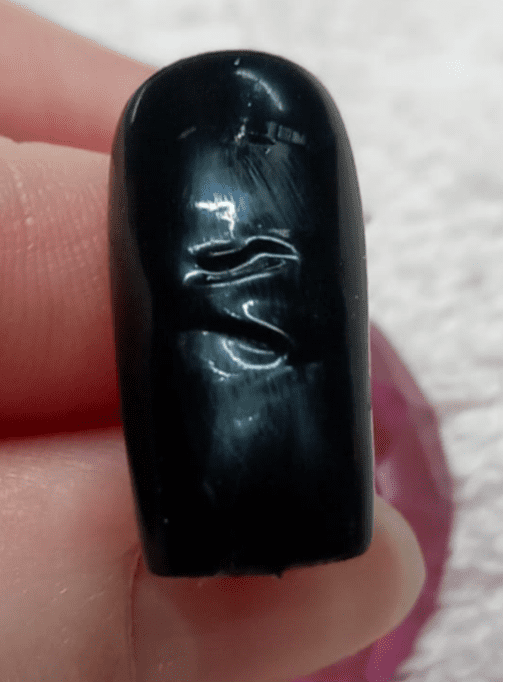
- El producto se aplica demasiado espeso
- La luz UV/LED no puede penetrar en el color. Cuando esto ocurre, la capa superior del producto se cura pero, como la energía UV no pudo llegar más profundo, la mitad inferior del producto permanece fluida.
- Apply 2 thin layers instead of 1 thick layer – don’t worry about blotching, the 2ndabrigo lo cubrirá.
- Check that your UV/LED lamp still works as well as it should. You can test this by placing some product on a form, curing it, then lifting it to see that the product is hard all the way through.
- La lámpara UV/LED no corresponde al producto
- Utilice la luz UV/LED adecuada para su producto.
Your UV/LED light is one of the most critical pieces of equipment in your salon. Nanometers are everything when it comes to product cure but even the best UV energy has trouble penetrating thick, dark colors, leading to product lifting.
Una de las mejores inversiones que hará será en la lámpara que se adapte a su producto. La siguiente mejor inversión es en sus propias habilidades de control del producto.
Descamación o desconchados:
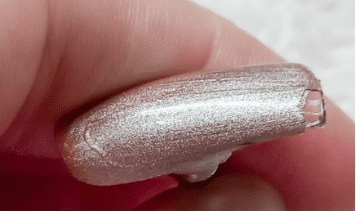
- La colocación de las manos en la lámpara no es como debería ser
- Check to see if the placement of your client’s hand is as it should be. Thumbs have always been a problem, but nowadays manufacturers create UV/LED lights with extra Light Emitting Diodes (the little lights) where the thumb should be.
- La placa de la uña no se preparó adecuadamente antes de la aplicación del producto
- A veces nos olvidamos de limpiar el borde libre con nuestro limpiador. También puede ocurrir que haya algo de polvo de lima bajo el borde libre. Tómate un minuto para darle la vuelta a la mano antes de aplicar el producto, para asegurarte. Cuando su cliente se lave las manos con agua y jabón antes de su PEP o PREP, dele un cepillo de uñas para limpiar bien debajo del borde libre. Seque bien y asegúrese de cubrir el borde libre no sólo con la capa base sino también con el color.
Placas de uñas inestables
- Placa ungueal limada demasiado fina
- Esto crea una placa ungueal inestable en el borde libre, pero también un gran problema cuando la uña crece.
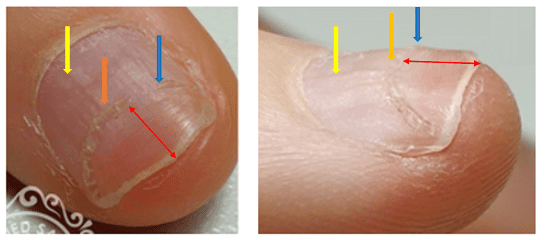
- Flecha amarilla: Una cresta normal en la placa ungueal, no es bonita pero podemos lidiar con ella.
- Flecha azul: Placa de clavos arrancada (las flechas muestran la misma posición en un ángulo diferente). El problema aquí no es sólo que su producto se levantará sino que está destrozado. El levantamiento del bolsillo es posible aquí también si ponemos producto en esto ahora.
- Flecha naranja: Placa de la uña arrancada (las flechas muestran la misma posición en un ángulo diferente)
- Flecha roja: La cantidad de placa de la uña llena delgada que necesita para crecer antes de que pueda hacer nada con el producto de uñas artificiales.
Product lifting is almost guaranteed and worse still, this client probably wants these ugly nails covered so the look amazing even if they are not. Explain how you’re going to solve the problem and why putting product on this nail plate is not a smart thing to do. The chances of a nail plate infection caused by WSO or PA is waiting to happen and any product you do apply will likely lift. That would be a waste of your time and a waste of your client’s money.
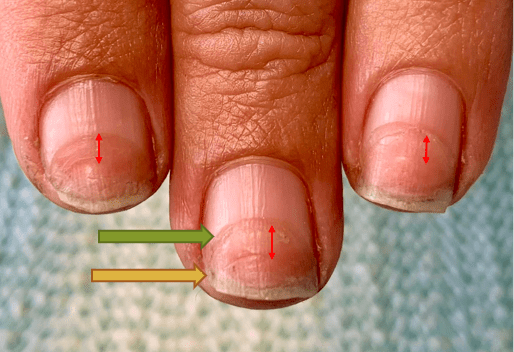
- Flecha verde: Daño de limado antiguo que crece
- Flecha amarilla: Daño de lima antiguo que crece
- Flecha roja: La cantidad de tiempo entre el servicio de uñas es visible. Si esta placa de la uña crece a un ritmo de 1 mm cada 10 días, entonces había unos 25 días entre las visitas al salón de manicura.
Mordedores de uñas
- Lo mejor que puedes hacer por un mordedor de uñas es darle un bote de aceite para uñas y piel. Haz que lo use cada vez que se meta el dedo en la boca.
- Nail biters only have minimal layers of nail plate left – remember the nail plate is in perpetual motion 24/7. If you have been to the seaside arcade with the penny machines that push the top coin into the drop tray – the nail plate cells work in the same way. Like an escalator in a store. Your product will always lift somewhere, and your client will always rip the rest off with their teeth.

The nails in Fig 5 took 11 months to treat with lots of quality oil & lotion. But now these nail plates are ready for any product or no product.
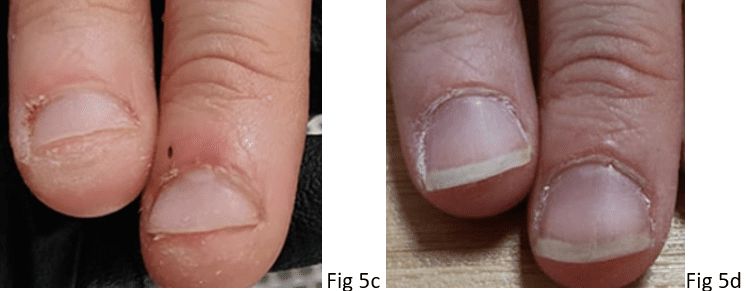
- Placa ungueal insuficiente para colocar el producto
- Los que se muerden las uñas siguen mordiéndoselas
- Fig 5c: intentar colocar productos para uñas en unos pocos milímetros de placa ungueal provocará desgarros y un trabajo de reparación interminable.
- Fig 5d: recovered nail plate ready for product, the client can still use more oil to help the proximal nail folds recover from keratinization, but the progress is obvious, now you won’t have a problem with product lifting, and the client can see the advantages of not biting 😊
Usando puntas en su mordedor de uñas:
I know a lot of nail techs do use tips on nail biting clients but try to resist the pressure, don’t be afraid he/she will go to another salon, explain the advantages of not doing it.
Los tips son una gran herramienta en el mundo de las uñas, pero una vez que tu mordedor de uñas mete sus dientes debajo de él, simplemente lo arrancará, esto causará aún más daño a la uña natural que estás tratando de hacer lucir hermosa.
Tips need glue to adhere to the natural nail, glue contains cyano-acrylates that are allergens if they come into contact with the skin and the chances of that happening with 1/3 of a nail plate to work with is high.
Also, all that damaged stratum corneum around the proximal nail fold – nightmare for perfect product placement with lifting being the inevitable result.
Oil, oil, and more oil – give it 6 weeks then strut your nail stuff!
Remember – A temporary fix may look good for a day or 2 but is not a real fix. Solve the nail plate problem first and you will have a client in your salon for life.
Tamaño y ajuste incorrectos de las puntas de las uñas artificiales
It’s important to choose the right size of tip for the nail of your client, but If in doubt use a flexible nail tip that is straight. Apply it only to the free edge of the nail (unless of course it’s a full cover tip – even then fit is really important).

If the tip is too big, you will create a flat C curve; if it’s too small, you will create a ‘staircase’ effect at the lateral nail fold and the free edge.
I’m going to keep this simple – Look for perfection training, all respectable brands have educators that do this.
Pegamento de punta
Todas las colas o resinas para puntas están fabricadas o contienen cianoacrilato de etilo o cianoacrilatos.
- Cyanoacrylates are a family of strong, fast-acting adhesives with industrial, medical, and household uses. They are derived from ethyl cyanoacrylate and related esters. The cyanoacrylate group in the monomer rapidly polymerizes in the presence of water to form long, strong chains. They have some minor toxicity.
- Ethyl cyanoacrylates are also used in forensics for lifting fingerprints when traditional fingerprint powder cannot be used, for instance on very delicate items. This happens in an enclosed chamber that is heated to allow the ethyl cyanoacrylate to turn into fumes and so show the hidden fingerprint.
- Los pegamentos de consumo disponibles en el mercado no son adecuados para aplicaciones cosméticas o médicas en manos/pies, ya que no son de grado cosmético o médico, lo que significa que sus formulaciones de disolventes y cianoacrilatos no se han evaluado ni optimizado para reducir la toxicidad y evitar cuerpos extraños o reacciones alérgicas.
Basically, they are all super glues, and all contain allergens – tenga mucho cuidado de que no entren en contacto con la piel.
Ethyl cyanoacrylate and cyanoacrylates have a limited shelf life. Solvents are added to the mix to help the adhesive solidify quickly. When you open a bottle of nail tip adhesive the solvents are evaporating, and the quality of the adhesive will reduce very quickly. If you don’t use it often, buy smaller bottles of 5ml and that will reduce wastage and frustration.
Pegamento viejo
Nail glue has a limited shelf life. The older it gets, the less likely it is to form a sufficient bond to hold the nail tip in place. This affects its ‘stickiness’, and your nail tip extension will not last.
También es importante recordar que los adhesivos para uñas tienen una vida útil limitada incluso cuando son nuevos. Esta es la razón por la que debe aplicar tips para uñas sólo en el borde libre de la uña, 2 mm = 2 semanas de crecimiento para la uña natural media.
La estructura de su producto de uñas artificiales es lo que mantendrá su mejora de extensión en su lugar.
Después de aplicar los tips, no elimine el exceso de polvo con alcohol o limpiador de uñas, ya que aceleraría la descomposición del adhesivo y/o debilitaría el tip de plástico. Es mejor quitarlo con un cepillo.
Si no se prepara correctamente la uña natural, siempre se producirá un levantamiento de la bolsa que, a su vez, se convertirá en el caldo de cultivo perfecto para patógenos residentes o transitorios como la pseudomonas aeruginosa.
Asegúrese de que su clienta entiende que con las extensiones de tips de uñas siempre tendrá que llevar guantes cuando realice cualquier tarea que implique otros disolventes y/o agua. Por eso las extensiones de uñas no son ideales para clientas que trabajan en bares u otros servicios.
Colocación incorrecta del formulario
La colocación de la forma es algo que hay que practicar y perfeccionar. Una vez que lo domines, no volverás a utilizar un tip de uñas.
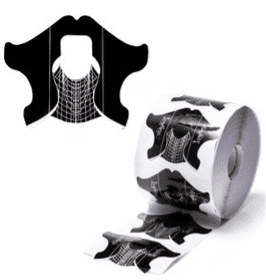
Forms have wings and lines. These are to ensure a perfect fit. Most brands have their own forms, all a little different in shape but all with the same goal in mind. Perfect form fitting creates a stable enhancement that fits the nail and the nail unit of your client. You can then place the artificial nail or extension with perfect alignment and balance.
Los problemas empiezan cuando se parte de una uña plana y no se ajusta la forma para que coincida. La forma tiene que asentarse perfectamente en the free edge of the natural nail, and you should create the C-Curve with the nail product. (See Picture E) If you leave a gap (because you are trying to create the C-Curve with your form) and the nail product leaks through the gap, even water from something simple like your client taking a shower will cause the product to lift in a matter of hours. (See picture D)

If you start with a curved nail and the form does not properly fit, the product will not cure as well as it should. Apply the product in thinner layers, and cure according to the manufacturer’s instructions.
With practice you will achieve this – see picture E
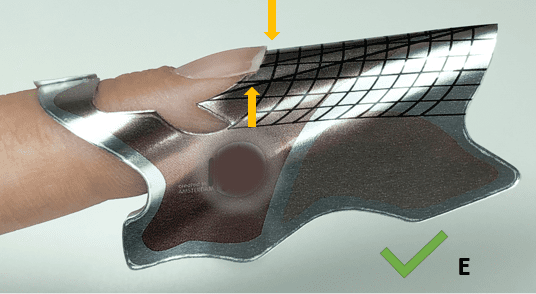
La aplicación de formas requiere práctica. Pregunte a su proveedor de la marca acerca de la formación sobre la perfección y la colocación de la forma. Cuando lo haga bien, no tendrá problemas de levantamiento del producto en los pliegues de la uña ni en el borde libre.
Producto en contacto con la piel durante la aplicación
Las células de la lámina ungueal se forman en la matriz y se abren camino a lo largo del eponiquio (donde está adherida la cutícula). A continuación, salen por debajo de la PNF, donde las vemos como la lámina ungueal normal. (La imagen F muestra esta acción en movimiento)
Esto ocurre 24 horas al día, 7 días a la semana. Las enfermedades o el embarazo pueden ralentizar o acelerar este movimiento.
If our product application is not as secure as it should be, maybe you’re in a hurry, maybe you didn’t bring your glasses to work or maybe the product you are using has a thin viscosity – the product might then drip into the lateral nail fold and become attached to your skin. (Figure G shows this)
En la MasterClass 1.2 podrás refrescar tu memoria sobre este tema.
Let’s have a look at pictures F & G
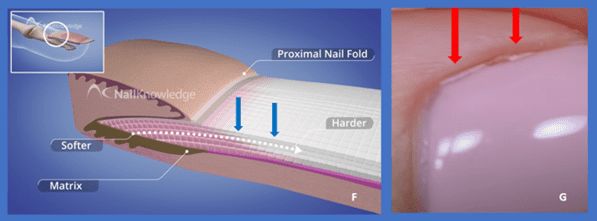
In picture F, you see 2 blue arrows; In picture G, two red arrows. So now imagine that they are in the same place in the lateral nail fold. F is in perpetual motion and G is static, the gel polish is hard and can only move with the nail plate. The gel polish that is in the nail grove will come loose and lift away, creating an opening. Water, oil, lotion, pathogens… Anything and everything can get between your gel polish and the nail plate! Product lifting will happen, and possibly an infection to boot!
Se necesita mucha práctica para colocar el producto perfectamente alrededor del PNF y de los pliegues laterales de las uñas. Por lo tanto, invierte en ti misma y tómate tu tiempo para aprender. Si dominas las líneas rectas con esmalte de uñas, te convertirás en una experta en líneas rectas en esmalte de gel. Dominar esto te hará más eficiente en el salón.
Mezcla incorrecta de líquido y polvo (sistema de uñas acrílicas)
El monómero líquido y el polvo acrílico combinados forman el sistema perfecto para mejorar las uñas. Una vez dominado es un producto realmente sorprendente.
Puedes utilizarlo para:
- Reconstrucción de uñas
- Reconstrucción de la placa ungueal
- Extensiones
- Reequilibrio
- It’s a reliable soak-off base for any system
- La base perfecta para uñas estriadas
- Esculpir la perfección
- Endless possibilities in nail art
Tiene desventajas:
- El monómero líquido huele
- La falta de ventilación puede provocar goteo de ojos, nariz y dolores de cabeza
- Too wet – can trigger allergies
- Too dry – your enhancement will not adhere well to the natural nail
- In the old days – it was hard to file
- Partículas finas de polvo
If you haven’t mastered L&P, product lifting becomes a problem.
Archivado excesivo
Básicamente, una aplicación desigual de L&P siempre provocará un levantamiento del producto o de la bolsa. Deberá limarlo hasta que quede uniforme. Eventualmente, limar a través del realce es una posibilidad real, y limar a través de la placa de la uña también lo es.
Using an acrylic brush you are not in control of, and a product that is too dry, may leave ‘doorsteps’ at the PNF. (see the red arrow in picture L)
La placa de la uña en el PNF está en su punto más blando, y esas células de la placa de la uña tienen que sobrevivir intactas durante 5 meses. Un limado excesivo aquí no sólo dañará su realce sino también la placa ungueal, y el producto se levantará. Del mismo modo, si la forma no se ajusta bien, la pared lateral del implante no será fuerte (véase la figura L, flecha amarilla) y el borde libre será irregular y débil (véase la figura L, flecha naranja).

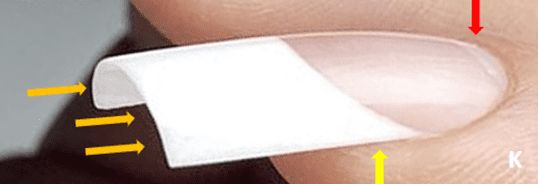
When the form is placed well and you have control of your L&P, you will not need to file excessively at the nail folds and your apex will be so strong the nail will last and last. (see figure K red, yellow and orange arrow)
Producto demasiado húmedo
Si la perla de L&P está demasiado húmeda, el producto que se desliza por los pliegues laterales de la uña (como en el ejemplo del esmalte de gel de la figura F) hará que el L&P se levante. Debido a que los sistemas L&P se secan al aire en lugar de curarse en una lámpara, usted tiene más tiempo para tirar suavemente y mantener la piel en los pliegues de la uña durante la colocación del producto y mantener el control del producto.
One more important reason for product lifting with L&P systems is shrinkage. L&P that is too wet will air dry at the wrong speed. When this happens, the excess monomer evaporates, the remaining polymer chains get pulled together, and the product tightens on the natural nail. This will not only cause pocket lifting that will be the perfect place for nasty pathogens, but it can actually be painful and heat will be generated by the chemical reaction caused by the polymers as they dry. Your client will experience this as uncomfortable pressure, maybe even intense heat hours later, and the enhancement will not last.
Practice, practice, a little patience, and lots of ‘bead making’ on practice sheets will ensure that you can create the perfect enhancement that will last longer than any other. A natural nail overlay with L&P will not only look stunning but, when placed well, it will wear as no other, and the rebalance will be done in 30mins.
No utilizar el sistema adecuado para el tipo de uña específico
Let’s go back to figure F. Remember the nail plate cells and their movement?
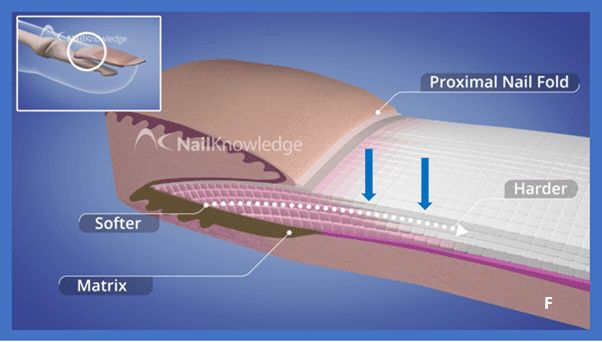
Marian Newman habla en Masterclass One de cómo el grosor de la placa ungueal viene determinado por la longitud de la matriz. Las células más nuevas de la lámina ungueal son más blandas, no están maduras.
Ahora imagina que tienes una uña amargada, con placas de uñas finas para empezar, que no puede resistir masticar su camino a través de la placa de la uña restante. ¡Nada bueno sale de poner un producto duro para esculpir sobre esa base tan débil! La razón por la que no irá bien es porque la base (la placa de la uña) tiene capas masticadas incompletas y está siempre en movimiento. El levantamiento de la bolsa será inevitable, con todo lo desagradable que ello conlleva.
Una placa ungueal débil necesita un producto flexible aplicado finamente (si you are going to use a product). I would recommend first recovering the nail biter’s nail plate before considering any product application. But, if you must, maybe for a wedding or a special occasion, use a clear fiber gel (figure J:)
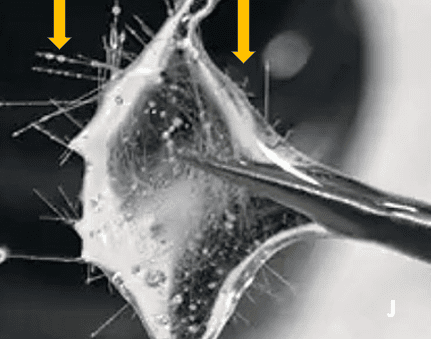
You can create simple small nails with a special effect nail varnish topcoat and your client will love you forever. He or she will have great looking nails with no problems, and you will be able to see through the product spotting any problems with lifting before things get out of hand. Get him or her to come back after the occasion – check that the nail coating is still intact, and no problems are occurring – if it’s not remove it!
Aquí es importante el entrenamiento, así como el mantenimiento de manos y uñas.
Elevación de bolsillo
- Trauma
- Pellizcos
- Debilidad de la lámina ungueal
- Infecciones
Elevación del productoen el contexto del cuidado de las uñas, se refiere a la separación o desprendimiento de los productos para uñas, como las mejoras acrílicas o de gel, de la placa de la uña natural. Este problema se produce cuando el producto de uñas aplicado pierde su adherencia a la uña natural, lo que da lugar a huecos entre el producto y la uña natural o incluso al desprendimiento completo. El levantamiento del producto puede deberse a diferentes factores, algunos de los cuales podemos provocar nosotros mismos (involuntariamente).


Trauma
If you knock the enhancement or nail coating while shopping, or while cleaning (even if you are wearing gloves) then the impact can cause the product to lift, and you won’t always see it from the outside. This pocket of air between the enhancement & the nail plate creates the perfect place for opportunistic pathogens. The problem is that because we have created gorgeous nails we don’t always see on time whats going on underneath – so a good rule would be, when in doubt, if you know you have knocked your nail remove the product to check if and what damage has been done and repair it as soon as possible.
Elevación de bolsillo
Pocket lifting occurs when the nail product separates from the nail plate but not around the edge. If you are wearing a clear product its visible but if you have created something amazing or using dark colors – you can miss it.
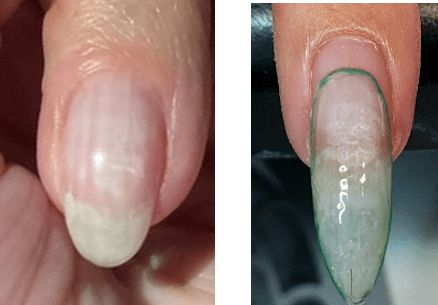
If it’s a natural overlay or a long extension – the result is the same, the nail enhancement is detached from the nail plate in the center – we can see it on the left nail because the enhancement is clear, on the right nail we only see it because we are rebalancing the enhancement.
Pellizcos
‘Pinching’ is something we do in competition to create the perfect C-Curve, it needs to be done well and with care because if we ‘pinch’ an artificial nail product and the nail product is too hard, product lifting becomes a real possibility. 30 years ago, pinching was the ‘norm’ and in competition is still a useful tool if you have been trained well.
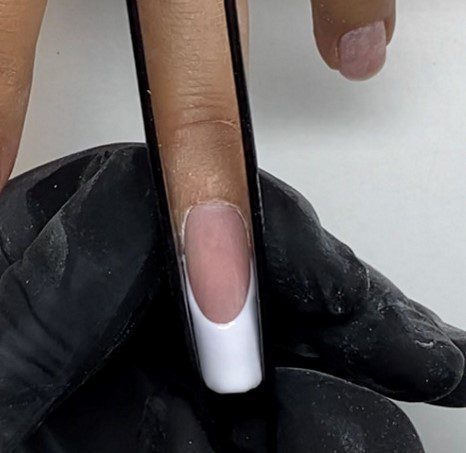
The C-Curve is pinched after product placement of the white to produce the perfect ‘C’ (This is done after the cover color is cured).
Today our products are more controllable and ‘building’ an apex and producing a C-Curve is easier if your colocación de formularios is well done but here also the rule is ‘product control is everything’ Done well you can produce gorgeous, long lasting nail extensions in the salon.
When you put the two side by side you see the difference but more importantly both effects are achieved without any pocket lifting – Product control, control of your pinching tool and good instructions are so important, you cannot achieve this kind of artificial nail without a good education and hours of training – but when you have mastered it, there is no looking back.
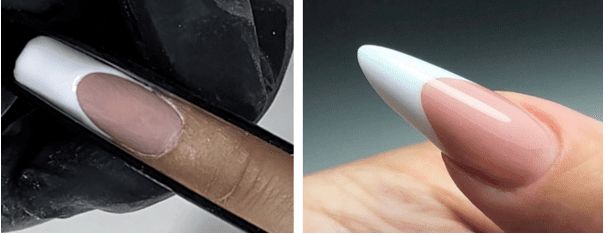
Inestabilidad o debilidad de la placa ungueal
If you ‘buff’ the natural nail before applying nail coatings of any sort, then, per definition, you are weakening the nail plate. If you also remove the skin from around the nail plate in the lateral nail folds & proximal nail fold, then you destabilize the entire nail plate. This creates an instability, a bit like building a house on sand instead of a solid foundation. Built on sand, the house will show signs of weakness or collapse, build on proper strong foundations the house will remain standing for as long as the building materials allow. The same is true for the nail plate when it ‘carries’ a nail coating. When the nail is intact and its surrounding seals are still in place the nail coating will remail attached to the nail plate for as long as the nail coating is made to last, if we remove any or all of the essential parts the nail plate becomes unstable and our nail coating will per definition become instable and weak.
Sometimes we get a little too enthusiastic when we are told to ‘remove the shine’ from our nail plate with a file. It’s better to think about replacing the búfer lima con un buen limpiador de la placa de la uña. El producto se adherirá bien a la uña natural y la lámina ungueal se mantendrá fuerte. Recuerde que la lámina ungueal tiene un grosor medio de sólo 0,380 mm. No es necesario limar mucho para eliminar no sólo su capa superior, sino que limar demasiado influirá definitivamente en su estabilidad e invitará a entrar a los patógenos.
También es posible que haya aplicado un recubrimiento de uñas en una uña dañada por un mordedor o un recogedor de uñas, la base es inestable y su recubrimiento de uñas es vulnerable, es más inteligente resolver primero el problema de la estructura de la placa de la uña.
There are professional products on the market that create an ‘interpenetrating polymer network, en the nail plate. Strengthening the nail plate while maintaining a healthy flexibility is important, however, you should make a plan to completely recover the nail plate before applying any product at all. Care & maintenance with oil & lotion is essential but your client may want an ‘instant result’ and of course, we understand that, but sometimes taking a little more time to recover the nail unit first is better for you and your client. If you understand why its important to take a little time to recover the nail unit first, you can explain this to your client and he or she will love you for it.
For ‘special occasions’ its possible to create gorgeous nails that stay in place for the occasion but that can be easily removed so that nail plate recovery or nail maintenance can continue after the fact – Using ‘Full Cover Tips’ or ‘Press on Show Tips’ could be a temporary option if you place them with care & remove them in accordance with the manufacturer’s instructions.
Infecciones
Las infecciones pueden ocurrirle a cualquiera, en cualquier momento, tanto si eres un técnico de uñas profesional o aficionado como si te haces tus propias uñas, y las infecciones en o alrededor de donde se ha levantado el producto son simplemente una consecuencia de que el producto se haya levantado.
We always have pathogens and microbiomes with us, they are a part of our normal daily life, most are essential to our wellbeing but sometimes, circumstances happen that create the perfect surroundings for them to allow their ‘nasty side’ to develop. Where your product is lifted from the natural nail becomes a cozy place for pseudomonas aeruginosa or WSO (white superficial onicomicosis) to develop and cause a riot. The problem is we can’t always see this happening because they are developing underneath our nail coatings.
Si nota que algo le ha causado un problema, tal vez sospeche de una infección, retire el revestimiento, límpielo bien, utilice los Protocolos de Primeros Auxilios, obtenga un diagnóstico y resuelva el problema antes de volver a aplicar el producto.
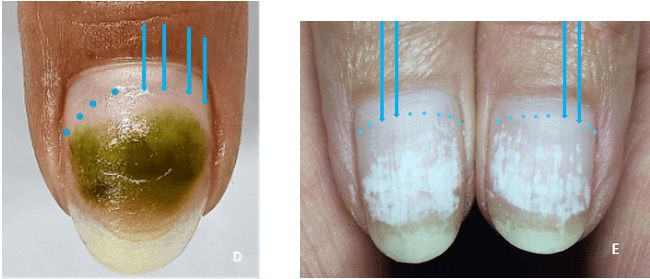
Fig D: Pseudomonas Aeruginosa after nail coating removal – the blue dots & arrows show where the edge of your nail coating was.
Fig E: White Superficial Onychomycosis after nail coating removal – again hidden under the nail coating.
Both of these infections are caused by our own body’s microbiome because we made it possible for them to develop. Hand & Nail maintenance with oil & lotion should be standard practice when artificial nail coatings or Nail Polish has been applied and we should be able to communicate this to our clients and to understand it ourselves whether we are DIY, students, or nail professionals – follow the same basic rules & the same hand & nail maintenance plan.
Placas ungueales afectadas por la hiperhidrosis
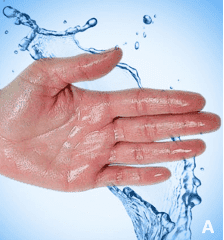
Excessive sweating or uncontrolled sweating (Palmer Hyperhidrosis) affects you’re the ‘cushioned’ part of your hands. Sweating occurs uncontrollably. Your hands may feel clammy or wet most of the time, it can happen at any temperature or during any season. The symptoms can increase in times of stress or anxiety. Socially it makes you feel uncomfortable shaking hands with someone, handing out papers at a meeting, or typing on a keyboard. Sweating happens without a trigger, not due to any external factor like exercising or an increase in body temperature. It can run in families, and it can be associated with other forms of hyperhidrosis or with certain medical conditions.
Puede afectar a las placas ungueales porque el exceso de humedad que se forma en el lecho ungueal y alrededor de la uña puede hacer que la placa ungueal quede blanda. Si su clienta padece hiperhidrosis, podría ser una contraindicación para la colocación de esmaltes de uñas por el riesgo de crear las condiciones perfectas para. Sólo se recomienda el esmalte de uñas.
Ref: 1. (véase el final de la página)
Colocación del producto debajo del PNF
Esta práctica, sin saber dónde empieza o acaba el eponiquio (durante un excesivo e-file manicura), es irresponsable.
Abusing the nail unit’s guardian juntas is not a part of a nail technician’s (legal) competencies. Should an infection occur, as a result, and your client or student chooses to sue you, means you will need to have good insurance.

Nail plate abrasion has taken place well behind where the PNF should be closed onto the nail plate, and the seals that protect the nail matrix from pathogens have been removed. If you proceed to place artificial nail product under the removed PNF and cure it in a UV/LED lamp, as many do… you are contributing to factors that could result in an acrylate allergy for your client.
El eponiquio no es visible desde el exterior de la unidad ungueal. Así que no tiene ni idea de si ha causado daños o no. Tampoco sabe cuánto producto se ha curado bajo el pliegue ungueal deformado que queda. El producto puede simplemente ser lavado o viajar de vuelta a la unidad de la uña.
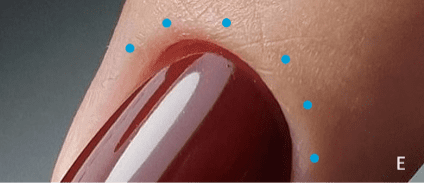
Soaking off product from nail units without guardian seals is a guaranteed way to invoke an acrylate allergy. Be very aware – By the time an allergy is recognized – it’s already too late.
Sistemas de mezcla
Todos lo hacemos y todos lo hemos hecho.
Mixing systems is fine if you are creating nail art for a Multimedia Tip Box Competition, assuming that you are working in a well-ventilated working area (as you should be). There is almost nothing more relaxing than doing that, especially if you have lots of unused nail stuff lying around. It’s a great way to use up all of it and maybe win a prize or 2 in the process. All good and all ok.
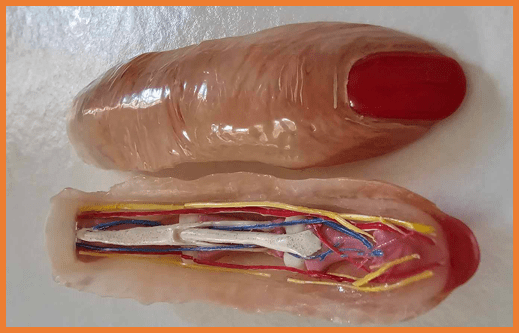
I’ve created some fingers for you, both the front and back sides. These practice nails are made from various artificial nail products, including leftovers such as acrygel, acrylic, paint, gel paint, nail glue, and plasti-love. These were never used on a client’s hand; they were just for fun. It’s a great way to make use of your surplus products and further develop your skills at home. 😊
But …
If you are creating gorgeous nails for a client that’s paying you money for the service, then you need to make sure that each layer of your enhancement is cured and layered as it should be. No matter if it is gel polish, acrygel, or acrylic.
Utilizando una imprimación o un aglutinante de la marca A y luego una capa base de la marca B, o incluso un gel constructor con una capa base incorporada de la marca B es buscarse problemas. Los 2 productos podrían, en lugar de coincidir, ser adversos el uno para el otro.
Primer A – goes into the upper layer of the nail plate. The base coat of brand A then goes on the natural nail. The 2 products bind with each other and create the perfect fix on the natural nail.
Bonder B – lays on the natural nail, and cures in a UV/LED lamp. It then creates a sticky layer for the base coat of brand B to bind with, creating the perfect fix on the natural nail.
If you use primer A and combine it with the base coat of brand B – you are mixing chemicals and have no idea if it causes a problem or not until it’s too late. The product can lift, or it can even repel from the nail plate entirely. Worse still, it can create a reaction that may cause an allergy or a burning sensation for yourself or your client.
Los químicos crean nuestros productos para uñas artificiales con esmero. Deje la química en sus manos.
Cualquier marca debería tener un sistema que funcione desde la imprimación o adherencia hasta la capa final.
Use the UV/LED light that belongs to the system you use – don’t risk under curing products!
Mixing them without knowledge is like putting diesel in a petrol motor car. You don’t know how much damage you do until it’s too late. Believe me, I know! I have done it and it was hilarious until I paid the bill for having the diesel removed and my engine cleaned!
- An Bras Dermatol. 2016 Nov-Dec; 91(6): 716–725. Hiperhidrosis palmar: aspectos clínicos, fisiopatológicos, diagnósticos y terapéuticos*
Flávio Ramalho Romero,1 Gabriela Roncada Haddad,1 Hélio Amante Miot,1 y Daniele Cristina Cataneo1

